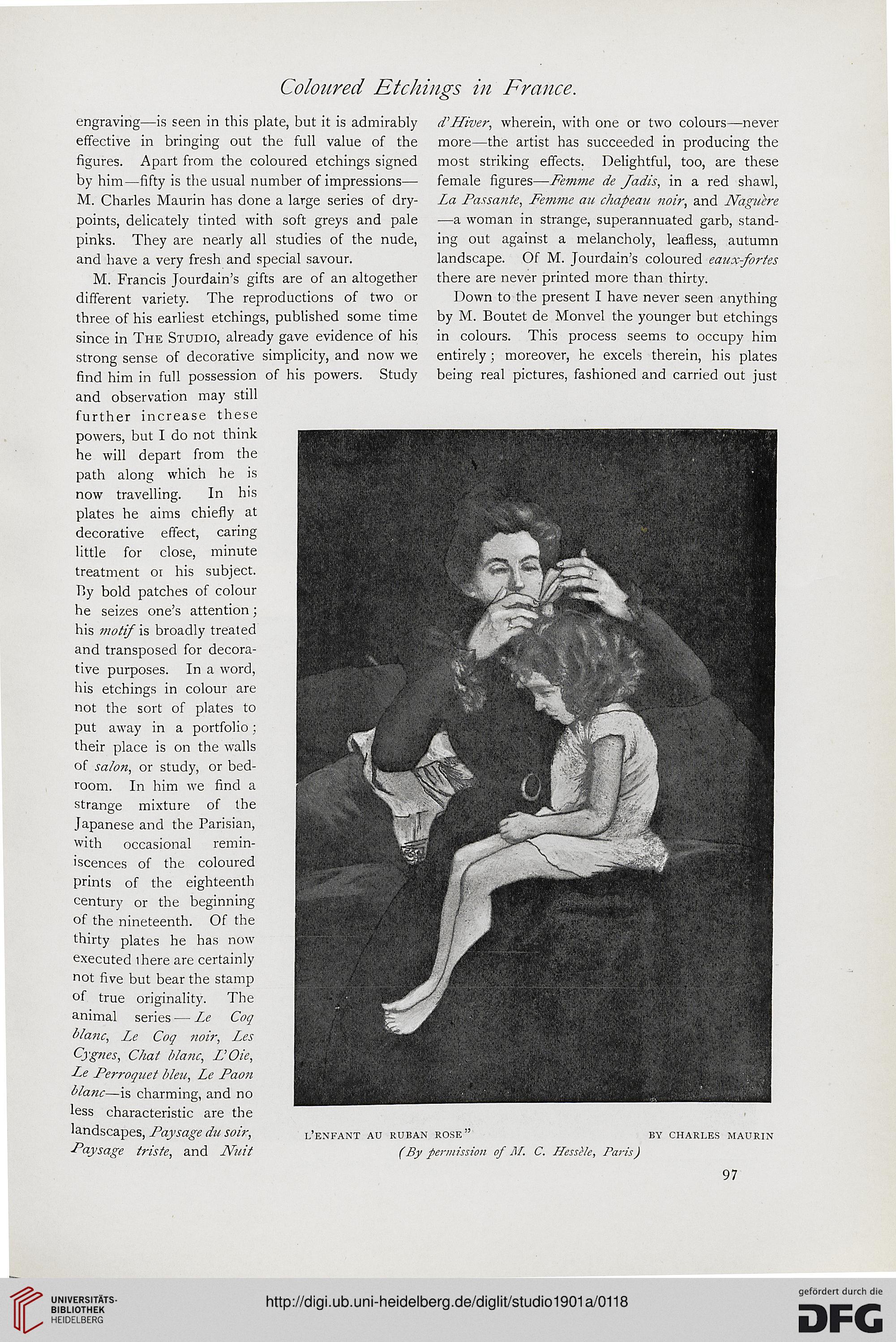Coloured Etchings in France.
engraving—is seen in this plate, but it is admirably d'Hiver, wherein, with one or two colours—never
effective in bringing out the full value of the more —the artist has succeeded in producing th
e
figures. Apart from the coloured etchings signed most striking effects. Delightful, too, are these
by him—fifty is the usual number of impressions— female figures—Femme de Jadis, in a red shawl,
M. Charles Maurin has done a large series of dry- La Passante, Femme aic chapeau noir, and Naguere
points, delicately tinted with soft greys and pale —a woman in strange, superannuated garb, stand-
pinks. They are nearly all studies of the nude, ing out against a melancholy, leafless, autumn
and have a very fresh and special savour. landscape. Of M. Jourdain's coloured eaux-fortes
M. Francis Jourdain's gifts are of an altogether there are never printed more than thirty,
different variety. The reproductions of two or Down to the present I have never seen anything
three of his earliest etchings, published some time by M. Boutet de Monvel the younger but etchings
since in The Studio, already gave evidence of his in colours. This process seems to occupy him
strong sense of decorative simplicity, and now we entirely ; moreover, he excels therein, his plates
find him in full possession of his powers. Study being real pictures, fashioned and carried out just
and observation may still
further increase these
powers, but I do not think
he will depart from the
path along which he is
now travelling. In his
plates he aims chiefly at
decorative effect, caring
little for close, minute
treatment 01 his subject.
P>y bold patches of colour
he seizes one's attention;
his motif is broadly treated
and transposed for decora-
tive purposes. In a word,
his etchings in colour are
not the sort of plates to
put away in a portfolio :
their place is on the walls
of salon, or study, or bed-
room. In him we find a
strange mixture of the
Japanese and the Parisian,
with occasional remin-
iscences of the coloured
prints of the eighteenth
century or the beginning
of the nineteenth. Of the
thirty plates he has now
executed lhere are certainly
not five but bear the stamp
of true originality. The
animal series — Le Coq
blanc, Le Coq noir, Les
Cygfics, Chat Mane, L'Oic,
Le Perroquet bleu, Le Paon
blanc—is charming, and no
less characteristic are the
landscapes, Pay sage du soir, l'enfant au ruban rose" by charles maurin
Paysage triste, and Ntlit (By permission of M. C. Hesstle, Paris)
97
engraving—is seen in this plate, but it is admirably d'Hiver, wherein, with one or two colours—never
effective in bringing out the full value of the more —the artist has succeeded in producing th
e
figures. Apart from the coloured etchings signed most striking effects. Delightful, too, are these
by him—fifty is the usual number of impressions— female figures—Femme de Jadis, in a red shawl,
M. Charles Maurin has done a large series of dry- La Passante, Femme aic chapeau noir, and Naguere
points, delicately tinted with soft greys and pale —a woman in strange, superannuated garb, stand-
pinks. They are nearly all studies of the nude, ing out against a melancholy, leafless, autumn
and have a very fresh and special savour. landscape. Of M. Jourdain's coloured eaux-fortes
M. Francis Jourdain's gifts are of an altogether there are never printed more than thirty,
different variety. The reproductions of two or Down to the present I have never seen anything
three of his earliest etchings, published some time by M. Boutet de Monvel the younger but etchings
since in The Studio, already gave evidence of his in colours. This process seems to occupy him
strong sense of decorative simplicity, and now we entirely ; moreover, he excels therein, his plates
find him in full possession of his powers. Study being real pictures, fashioned and carried out just
and observation may still
further increase these
powers, but I do not think
he will depart from the
path along which he is
now travelling. In his
plates he aims chiefly at
decorative effect, caring
little for close, minute
treatment 01 his subject.
P>y bold patches of colour
he seizes one's attention;
his motif is broadly treated
and transposed for decora-
tive purposes. In a word,
his etchings in colour are
not the sort of plates to
put away in a portfolio :
their place is on the walls
of salon, or study, or bed-
room. In him we find a
strange mixture of the
Japanese and the Parisian,
with occasional remin-
iscences of the coloured
prints of the eighteenth
century or the beginning
of the nineteenth. Of the
thirty plates he has now
executed lhere are certainly
not five but bear the stamp
of true originality. The
animal series — Le Coq
blanc, Le Coq noir, Les
Cygfics, Chat Mane, L'Oic,
Le Perroquet bleu, Le Paon
blanc—is charming, and no
less characteristic are the
landscapes, Pay sage du soir, l'enfant au ruban rose" by charles maurin
Paysage triste, and Ntlit (By permission of M. C. Hesstle, Paris)
97




